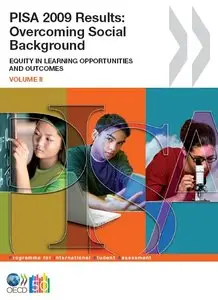PISA 2009 Results: Overcoming Social Background: Equity in Learning Opportunities and Outcomes (Volume II)
OECD | 07 Dec 2010 | ISBN: 9264091504 | 224 pages | PDF | 7 MB
OECD | 07 Dec 2010 | ISBN: 9264091504 | 224 pages | PDF | 7 MB
Volume II of PISA's 2009 results looks at how successful education systems moderate the impact of social background and immigrant status on student and school performance. The volume opens with an introduction to PISA and a Reader's Guide providing information that will help readers understand the data.
Chapter 1 focuses on the magnitude of differences in student performance across countries and the extent to which these differences relate to socio-economic background.
Chapter 2 examines the extent to which students and schools with different socio-economic backgrounds have access to similar educational resources, and the impact of background and school on learning outcomes.
Chapter 3 examines the relationship between student performance and different aspects of socio-economic background.
Chapter 4 compares the performance of students with an immigrant background with the performance of other students.
Chapter 5 analyses the impact of socio-economic background of schools on reading performance.
The final chapter examines policy implications of the findings.
Annexes provide detailed statistical data and technical information.
Table of Contents
Executive summary
Introduction to PISA
Reader’s Guide
Chapter 1 Moderating the impact of socio-economic background on educational outcomes
Interpreting gaps and dispersion in student performance
Family and socio-economic background
Socio-economic background, underlying social and economic inequality and mean performance at the level of the education system
Looking ahead
Chapter 2 Three pe rspe ctives on educational equity and equality
Equality in learning outcomes
• Relative performance gaps within countries
• Share of the students failing to reach a baseline level of proficiency
Equity in the distribution of educational resources
Equity in learning regardless of student background
• Family and socio-economic background
• Family structure
• School location and variation in performance across geographical areas
Chapter 3 Learning outcomes and socio-economic background
Students’ socio-economic and cultural status and performance
The socio-economic gradient: an approach to equity in PISA
A comparative perspective on socio-economic gradients
Student resilience in PISA: the proportion of disadvantaged students who succeed in PIS
Chapter 4 Learning outcomes of students with an immigrant background
Students with an immigrant background
The size of the immigrant-background student population and mean performance of the system
Performance gaps across immigrant status
First-generation students and age of arrival
Immigrant status and home language
Performance, immigrant status and country of origin
Immigrant status and school resources
Chapter 5 School systems and the impact of socio-economic background
The relationship between performance and socio-economic background
Performance differences within and between schools
Differences in the socio-economic background of students and schools
Performance differences and the socio-economic background of students and schools
Predicted and actual performance of students in different socioeconomic contexts
Performance, socio-economic background and the role of parents
Performance, socio-economic background and participation in pre-primary education
Policy Implications
Patterns in the relationship between performance and socio-economic background
A disproportionate number of low-performing students
Different slopes and strengths of socio-economic gradients
• Gentle slopes and weak-versus-strong gradients
• Steep slopes and weak-versus-strong gradients
Different socio-economic profiles
Differing gradients across schools
Differing gradients within schools
References
Annex A Te chnical Background
Annex A1: C onstruction of reading scales and indices from the student, school and parent context questionnaires
Annex A2: T he PISA target population, the PISA samples and the definition of schools
Annex A3: Standard errors, significance tests and subgroup comparisons
Annex A4: Quality assurance
Annex B Tables of results
Annex B1: Results for countries and economies
Annex B2: Results for regions within countries
Annex C The development and implementation of PISA – A collaborative effort
with TOC BookMarkLinks
More : You find here



